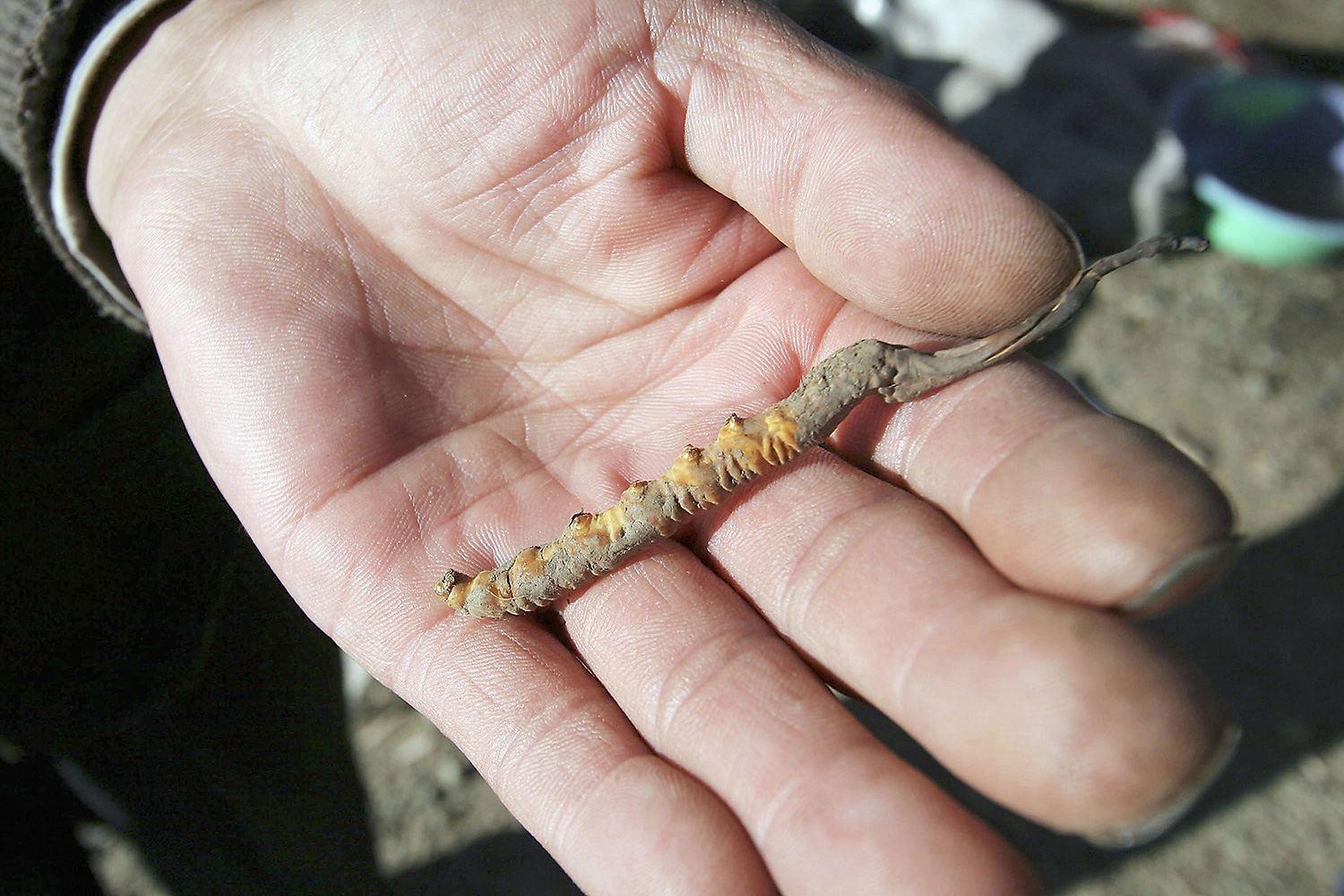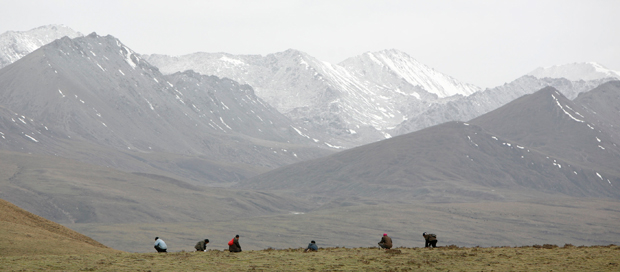Mushroom gatherers converge and crawl on hillsides in Qinghai province every March while foraging for wild caterpillar fungus.
Theirs is not a garden-variety morel hunt. Caterpillar fungus is a hard-to-find parasite that infects and mummifies a host before forming a mushroom, the tip of which sprouts from the head of an unlucky caterpillar.
Favored for hundreds of years by practitioners of traditional Chinese medicine, the fungus is used to treat a variety of ailments. And that makes it valuable: Mushroomers from area villages who flock to Tibet Plateau hills in Qinghai every spring can sell one victimized caterpillar for up to 100 yuan.
Trouble is, experts say, commercialism and over-harvesting are slowly decimating the caterpillar fungus as well as other medicinal forms of life growing wild on the plateau and in other remote areas across China.

Herbal medicine experts say natural habitat destruction and unsustainable foraging are threatening a wide range of wild health products. Among the 398 endangered plants listed in the China Red Plant Data Book, published by the Ministry of Environmental Protection, 168 are used in traditional Chinese medicine.
And of the nearly 3,000 endangered plant species in China, more than 60 percent are widely used by traditional Chinese medicine doctors for treating their patients.
The pressure on wild plants has increased in recent years with surging demand for traditional medicine and the rise of a middle class in China. At the same time, say experts, environmental protection monitoring of Tibet Plateau hills and other wild habitats has declined.
Mushrooming Market
The decline in supplies of traditional herbs is a decades-old phenomenon. More recent is the steady increase in prices.
Last year, for example, caterpillar fungus fetched between 120,000 and 160,000 yuan per kilogram. A single mushroom stem with good appearance and quality could easily sell for 70 to 80 yuan in Zhejiang or Guangdong province, the biggest domestic markets for medicinal supplies.
Data released in July by the China Association of Traditional Chinese Medicine indicated the price of caterpillar fungus had jumped roughly 30 percent this year.
Some say there’s a bubble in the market. At Tongrentang shops, the best-known retailer of traditional Chinese medicine, top-shelf caterpillar fungus goes for 888 yuan per gram—more than twice the price of gold.
But Tibet Plateau nomads and villagers who have been gathering the mushroom for years say prices are rising in sync with a countdown to its extinction.
Mushroom harvester Rongga, a sixty-five-year-old Tibetan woman who lives in Qinghai’s Yushu County, said she spends at least a month in the mountains every year gathering the fungus. During that time, she collects less than 500 grams.
Yushu was once famous for the highest quality caterpillar fungus in the world. Now, agriculture and forestry officials working for the Tibet and Qinghai governments predict next year’s supply will be extremely low, marking an unprecedented decline in availability.
The area has been attracting increasing numbers of visitors who join locals each spring in hopes of capitalizing on caterpillar fungus gold rush. An official from the Yushu Poverty Alleviation Office who declined to be named said current resources for conservation enforcement are not sufficient to stem the growing tide of collectors from outside the region.
Rongga said too many people are collecting caterpillar fungus, supplies of which have fallen to unsustainable levels. The visitors also destroy habitat while harvesting, she said.
“They use shovels to dig holes, and leave behind ditches larger than 20 centimeters in depth,” she said. “The holes aren’t refilled and this changes the landscape.”
Tibetans and other local foragers habitually and carefully refill holes during caterpillar fungus collections to ensure future harvests.
Ransacking Hills
According to the China Academy of Science’s Northwest Institute of Plateau Biology, dozens of medicinal herbs only found in Tibet and Qinghai face extinction due to exploitative harvesting practices.
Chinese rhubarb, a medicinal plant once widely used in traditional Chinese and Tibetan medicine, is one of them. The herb is considered a basic component of more than 800 traditional medicine treatments.
Indeed, due to the shortage, Qinghai’s Tibetan medicine pharmacies have been forced to purchase artificially cultivated rhubarb from neighboring Gansu province.
The institute’s report said the main growing area for the rhubarb has moved up the mountains to 4,200 meters above sea level, beyond the reach of most collectors.
Peng Min, a researcher who has studied the chemistry of Chinese medicinal plants for twenty years, said he thinks nearly all of the most widely used herbs are headed for extinction, given current harvesting practices. In addition, Peng said, researchers now approach field work with the understanding that any medical discoveries could result in a harmful spasm of commercial demand for the plant.
Peng said there’s a trend toward depletion perpetuated by Chinese medicine manufacturers. The popularity of traditional treatments spurs manufacturers to push up prices of wild herbs. Once the plants are rapidly removed from the natural environment, supplies are driven down.
Paris polyphylla is an herb that suffered extensive harvesting in the aftermath of the deadly 2003 SARS epidemic. Traders have offered 500 yuan per kilo, which has contributed to over-harvesting. Experts say it’s being collected at a pace that could lead to its disappearance in Pingwu County, Sichuan province, which was once a major collection area for the herb.
Dendrobe, considered as nutritious and healthful as ginseng, was once abundant in southern China. This year, the Ministry of Environmental Protection announced that the plant no longer grows wild anywhere in China. Enterprises producing dendrobe-containing drugs rely solely on imports from Southeast Asia.
Greater Catastrophe
The extinction of one species of plant can lead to death for other organisms. A 2011 survey by the Research Center for Eco-Environmental Sciences under the China Academy of Sciences provided vivid examples. The marked decline of birthwort, for example, put the survivability of twenty unique species of swallowtail butterflies in danger. The unlimited excavation of Rhodiola kirilowii, a plant often used for gynecological applications in Chinese medicine, is eliminating homes for the Parnassius glacialis butler butterflies that live on the plant.
Some have suggested medicinal plant farming may be the only way to preserve natural ingredients for traditional Chinese medicine.
However, Wei Lixin, a member of Medicinal Ethics Committee of the Chinese Pharmacopoeia Commission, said cultivated herbs can be costly and are less attractive to drug companies.
The use of farming to ensure supply requires massive investments for a company to receive proper certification from the government, said Wei. And herb cultivation results can vary: It can take three to five years for herbs to mature before quality can be determined.
At present, only northwestern institute scientists have successfully cultivated seven types of wild medicinal plants in China. But it required heavy investment and trained researchers, which are more expensive than natural habitat conservation for wild plants.
Peng said the traditional medicine industry should break away from its business model, which relies on harvesters in the wild. But he doesn’t expect government regulators to lead the change.
“The first-come, first-served approach to harvesting requires alternative solutions,” he said. “But the government isn’t going to be the one to deliver it.”




